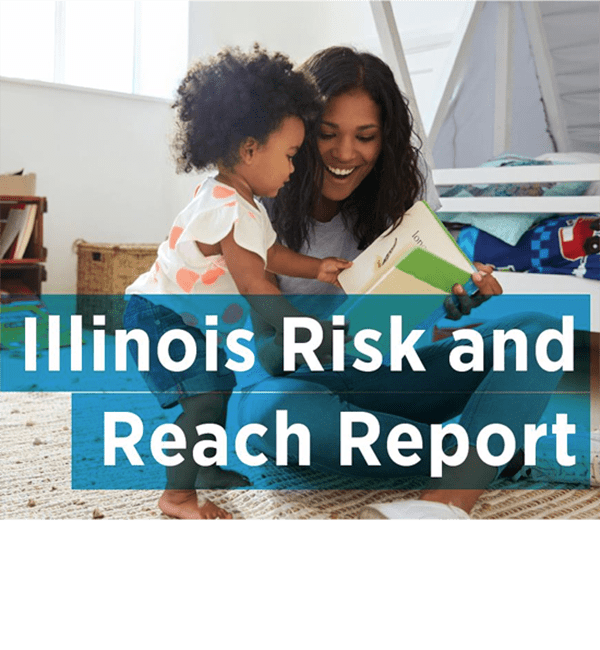New data tool providing county-by-county data on the well-being of children in Illinois
CHICAGO, ILLINOIS, April 25, 2019 — Children age five and under make up 7.4 percent of the 12.8 million residents of Illinois. Of that total, 643,768 children (68.1%) live in the 51 counties that are considered High-Moderate or High Risk — areas where circumstantial conditions outside of individual control can undermine child development. To give all young children the best start and ensure greater equity, the Illinois Risk and Reach report visualizes county-by-county data through maps and tables to better understand the well-being of children across the state in relationship to the reach of Illinois’ early childhood efforts. The inaugural Report can be downloaded here. A brief video explaining what the reports is, and how it can be used, can be viewed here.
This Report distinctly defines risk as being situated in the environment rather than associated with the individual and rejects the notion that children or communities are inherently “at-risk.” And while risk factors do not necessarily determine a child’s developmental trajectory, the accumulation of risk factors across a lifespan, particularly in the early years, can affect optimal growth and development. The Report shows how every county has strengths and challenges, but the key is to build on strengths and identify areas for improvement. Research by Nobel Laureate economist, James Heckman, shows that strategically investing in health, early care and education, as well as family services, can improve health outcomes, academic achievement and the future success of children. Data found in the Report can help local leaders and state officials identify gaps and mitigate risk factors—adding or expanding services, for example. On a broader scale, it can inform conversation and ignite action leading to more effective early childhood policy, systems alignment, and equitable distribution of resources.
The Report’s 32 detailed maps and tables are organized under one of three domains—Family Stability, Health, and Early Care and Education—and can be explored at the interactive website: RiskandReach.erikson.edu. Risk factors include poverty, lead exposure, maternal morbidity, homelessness, and childcare costs—among others. Reach indicators, publicly funded services and programs to address risk factors, include income assistance, lead testing, prenatal care, child care subsidy and more. The Report is designed to inform:
During a March 11 public panel at City Club of Chicago, Erikson’s President and CEO Geoffrey A. Nagle explained the immediate benefits of the Report, saying, “For the first time, with the Risk and Reach report, we have the information to ask insightful and detailed questions about how the children and families in our communities are doing.” Joining the conversation was Lieutenant Governor Juliana Stratton, a fellow of Erikson’s Early Childhood Leadership Academy’s McCormick Foundation Executive Fellows program, which is designed for influential leaders who want to advance early childhood policy. She shared, “We need to be strategic about where investments can be made. When we talk about what’s best for children ages five and under, it impacts all of us. We must prioritize those needs.” Stratton spoke to the report’s county-by-county approach and pairing it with a fiscal scan of the State’s investments, “This report connects the dots in so many ways,” she said. “We need to connect the dots in Springfield instead of looking at factors in singular, siloed ways.”
Dialogue is Key to Making Meaning of Data
The Report illuminates the strengths, opportunities, and trends related to how Illinois can and should support child well-being. To make meaning of the data, it is critical that data is contextualized by local leadership, inclusive of beneficiaries, and in collaboration with State leaders tasked with allocating, administering, and implementing public programs and services. Stakeholders developing action strategies are encouraged to use local knowledge and resources to find the most effective and sustainable solutions. On April 30, Erikson and Illinois Action for Children will host a webinar to explore ways early childhood collaborations across the state can use the Report’s data to support their efforts.
The Risk and Reach report is a collaborative effort of Erikson, Illinois Early Childhood Asset Map (IECAM) at the University of Illinois Urbana-Champaign, and The Fiscal Policy Center at Voices for Illinois Children to ensure young children have access to high-quality early childhood programs, services, and equitable opportunities to thrive. The Risk and Reach report was generously funded by The Irving Harris Foundation, The Robert R. McCormick Foundation, The J.B and M.K Pritzker Family Foundation and the W. Clement & Jessie V. Stone Foundation.
Erikson Institute educates, inspires, and promotes leadership to serve the needs of children and families. We have the premier graduate school dedicated to child development. We provide direct services to our community’s most vulnerable children and families. We are leaders in influencing early childhood policy. We work tirelessly every day so that all children can achieve optimal educational, social, emotional, and physical well-being. At Erikson Institute, we know that investing in the early years of children will last a lifetime.
###

Join the Erikson family with monthly news + events updates shared by academics, community members, and families.